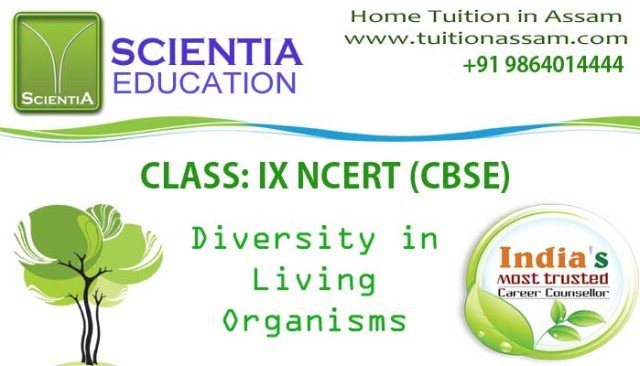
CLASS: IX NCERT (CBSE)
Diversity in Living Organisms
SUMMARY
Aristotle, the Greek philosopher, classified animals based on whether they live on land, in water or in the air.
Classification of living organisms is based on characteristics and divided the animals into groups and sub-groups.
Charles Darwin put forward the idea of evolution in 1859, in his book, The Origin of Species.
Ernst Haeckel, Robert Whittaker and Carl Woese have tried to classify living organisms into broad categories, called kingdoms. Kingdom subgrouping into Phylum for animals or Division for plants, Class, Order, Family, Genus and Species is called hierarchical classification.
The scientific naming or nomenclature was introduced by Carolus Linnaeus.
The method of naming of an organism with genus first and the species later is called binomial nomenclature.
Conventions followed while writing scientific names includes the name of the genus should begin with a capital letter and the name of the species should begin with a small letter.
Monera includes prokaryotic cells which lack organized nucleus and membrane bound cell organelles. Monera are autotrophic, so they derive their nutrition by synthesizing their own food.
Protista are unicellular and the simplest form of eukaryotes and includes algae, diatoms and protozoans.
Most fungi are multicellular and eukaryotic and include mushrooms, rhizopus and mucor.
Both fungi and algae together live in a symbiotic relationship, called lichens.
Fungi decay dead plants and animals to derive their food, hence called saprophytes.
Some fungi live in a mutual relationship with blue-green algae, this relationship is called symbiosis.
Plantae includes all plants that are multicellular and eukaryotic with cell walls made of cellulose.
Animalia includes all the animals that are multicellular, eukaryotic without cell walls.
Photosynthesis is the process by which plants use energy from the sun to convert water and carbon dioxide into sugar and release oxygen into the atmosphere.
Criteria for plant classification is based on features like: does the plant have distinct parts like stem, roots and leaves, do these parts have tissues that transport food and water, does the plant bear naked seeds and are these seeds enclosed in fruits.
Eichler classified the plant kingdom into two sub-kingdoms Cryptogamae and Phanerogamae.
Cryptogamae includes plants with hidden reproductive organs and plants do not bear flowers or seeds.
Thallophyta are the simplest of plants that do not have a well-differentiated body design.
Algae do not have leaves, stems or roots.
Bryophyta are often called amphibians of the plant kingdom as they require both aquatic and terrestrial conditions for the completion of their life cycle.
Moss or Funaria belongs to the group Bryophyta. Bryophyta include Riccia and Marchantia.
Pteridophyta include fern plants, in which the plant body is differentiated into stem, leaves and roots and also have naked embryos in the form of spores underneath the leaf.
All plants that develop seeds and have well-formed stem, leaves and roots, belong to the sub-kingdom Phanerogamae.
Gymnosperms include the plants with naked seeds.
Angiosperms include the plants with flowers and seeds enclosed in fruits. Embryos in these seeds have ‘seed leaves’ called cotyledons.
Cotyledons supply food to the growing embryos, when the seeds germinate.
An amazing variety of flora and fauna are included in the chart-classification of plant kingdom.
Differences between monocots and dicots plants includes the variation in seed, root and in leaves.
Animalia classification includes Invertebrata and Vertebrata.
Invertebrata classification is characterized by absence of vertebral column.
Porifera includes Sycon, Spongilla and Euplectella. Sponges are covered with spongin fibres and has canal system.
Coelenterata includes Hydra, Obelia,Corals and Sea anemone and has gastrovascular cavity.
Coelenterates are radially symmetrical. Platyhelminthes are acoelomates, triploblastic and bilaterally symmetrical. Tapeworms includes Liver fluke and Planaria.
Platyhelmenthes are also called flatworms. Nematoda includes Ascaris, Enterobius and Wuchereria. Filarial worms cause elephantiasis.
Annelida includes earthworms and leeches and has true coelom.
Arthropoda includes Honey bees, Spiders, Prawns and Centipedes and has open circulatory system.
Mollusca includes chiton, mussel, snail and octopus. Echinodermata includes starfish, sea cucumbers and sea urchins and have tube feet for locomotion.
Protochordata has notochord and includes Balanoglossus, Herdemania and Amphioxus.
Basis for vertebrata classification are notochord, dorsal nerve cord etc.
Classification of vertebrata includes Pisces, Amphibia, Reptilia, Aves and Mammalia
Fishes includes cartilaginous and bony fishes. Fish heart is 2 chambered. Salamanders, frogs and toads are tetrapods.
Amphibian heart is 3 chambered. Reptiles includes lizards, chameleons, flying lizards, snakes, crocodiles and turtles. Crocodile heart is 4 chamberted.
Reptilian heart is 3 chambered.
Aves includes birds like sparrows, penguins and eagles. Bird heart is 4 chambered. Modification of fore-limbs in birds into feathers.
Mammalia includes platypus, kangaroo, polar bear and dolphin. Mammalian skin maintains body temperature. Mammals have mammary glands. Mammalian heart is 4 chambered.














